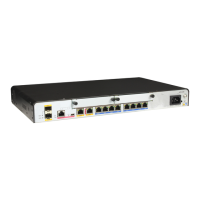Card Name Usage Scenario
Annex M Annex M expands the upstream frequency band of ADSL and provides
a higher upstream transmission rate.
G.992.3 and G.992.5 each define Annex M:
l Annex M defined in G.992.3 and Annex M defined in G.992.5 have
the same upstream frequency band.
l They have different downstream frequency bands:
– The maximum downstream frequency band of Annex M defined
in G.992.3 is 1104 kHz.
– The maximum downstream frequency band of Annex M defined
in G.992.5 is 2208 kHz.
Functions and Applications
Functions
The ADSL-A/M and ADSL-B each provide 1-channel ADSL/ADSL2+ access, provide
independent CPU and management interfaces, and support ADSL2+ Annex A, Annex B, and
Annex M specifications.
The ADSL-A/M or ADSL-B consists of the following modules:
l CPU control module: manages the system and loads programs.
l ADSL2+ module: implements ADSL2+ modulation and demodulation on CPEs.
l SGMII upstream module: provides one SGMII upstream interface to communicate with
the active and standby SRUs.
l Power supply module: conducts power from backplane to card.
l Clock module: provides two types of working clocks for cards.
Applications
The ADSL-A/M and ADSL-B can be installed into the SIC slot of the AR1200, AR2220,
AR2240 and AR3260.
Panel and Interfaces
NOTE
The ADSL-A/M and ADSL-B panels are identical except for having different silkscreens. The following
describes the panel and Interfaces of the ADSL-A/M.
Figure 5-26 shows the appearance of the ADSL-A/M.
Figure 5-26 Appearance of the ADSL-A/M
Huawei AR1200&2200&3200 Series Enterprise Routers
Hardware Description 5 Cards
Issue 03 (2012-04-20) Huawei Proprietary and Confidential
Copyright © Huawei Technologies Co., Ltd.
116

